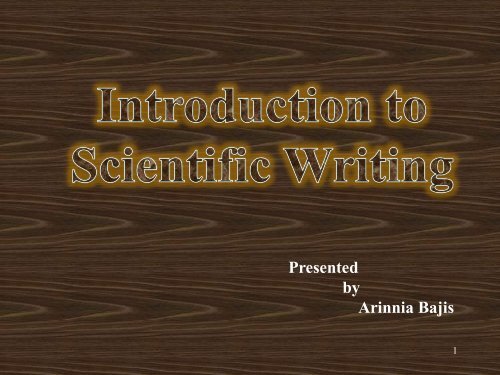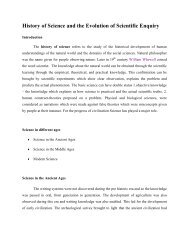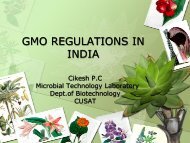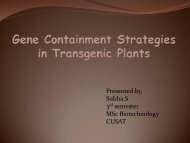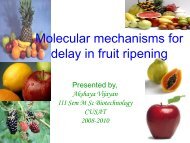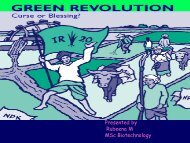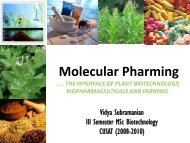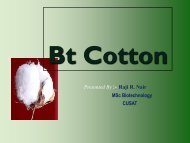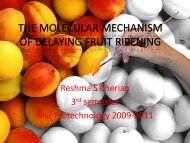Sentence structure
Sentence structure
Sentence structure
Create successful ePaper yourself
Turn your PDF publications into a flip-book with our unique Google optimized e-Paper software.
PresentedbyArinnia Bajis1
Introduction to Scientific Writing1) Writing guides and websites2) Why study English?3) <strong>Sentence</strong> <strong>structure</strong>4) Paragraphs5)Tips to <strong>Sentence</strong>s6) General rules2
Useful Web sites about writing:Writer’s Handbook: Scientific Reportshttp://www.wisc.edu/writing/Handbook/ScienceReport.htmlA guide to grammar and stylehttp://newark.rutgers.edu/%7Ejlynch/Writing/contents.htmlGrammar, Punctuation, and Spellinghttp://owl.english.purdue.edu/handouts/grammar/index.htmlMerriam-Webster Online Dictionaryhttp://www.m-w.com/A Dictionary of Units of Measurementhttp://www.unc.edu/%7Erowlett/units/index.html
Introduction to Scientific Writing1) Writing guides and websites2) Why study English?4
Why study English?English is the universal language,especially in science.For scientists,English is the only language.5
Susumu TonegawaNobel Prize for Medicine - 19876
Why study English?After he won the Nobel Prize,Susumu Tonegawa wrote hiscolleagues in Japan and toldthem:“Learn English!”7
Why English?• Most scientific papers in the 20 th century werepublished in English, creating a scientific terminologythat is English based• Thus, there is no need to reinvent terms for new ideasand concepts in a new language. For example, newwords were created for “restriction enzyme” in French,German and Afrikaans• Understood by the largest number of scientiststhroughout the world8
Language problems?Young scientists, especially non-native speakers (NNS) sometimesface language problems in expressing their ideas or findings inEnglish.It is not surprising as English isEnglish is not only rooted learned in or their studied culture. as a subject in high school andhigher education. The patterns and rules of English are, to someextent, different from their first language (e.g. Indonesian). TheIndonesian language does not have any tenses;Speakers or writers must able toshare their ideas withworld.9
Not all non-native speakers have trouble communicating inEnglish. Many speak at a native level, but many do not.The ability to communicate with people who speak or write arelack of practice in English ,,,,It is a skill that can be developedover time with practice.10
LANGUAGE IN SCIENTIFIC WRITINGThe language of science or scientific papers differs from thatliterary worksA scientist who uses complicated, metaphorical or ambiguoussentences may mislead the readers: accordingly his messagewill not be properly understoodBoth written and spoken language always involve a set ofgrammatical rules. Those who do not master such rules properlywill not be able to write a good scientific paper or speak Englishcorrectly.11
Introduction to Scientific Writing1) Writing guides and websites2) Why study English?3) <strong>Sentence</strong> <strong>structure</strong>12
<strong>Sentence</strong> Structure• Readers expect certain types ofinformation to occur in particularplaces in a scientific paper.• One of the biggest problems inprofessional writing is misplacementof information in a sentence.13
<strong>Sentence</strong> <strong>structure</strong>Subject – Verb – ObjectEnglish, Chinese, ThaiEnglish:Thai:I eat carrot.Pŏm taan bplaa-mùk.14
<strong>Sentence</strong> <strong>structure</strong>Subject – Verb – ObjectSubject – Object – VerbEnglish, Chinese, ThaiJapanese, Korean, Hindi15
<strong>Sentence</strong> <strong>structure</strong>Subject – Verb – ObjectSubject – Object – VerbEnglish, Chinese, ThaiJapanese, Korean, HindiThese two patterns account for>75% of the world's languages.16
<strong>Sentence</strong> <strong>structure</strong>Subject – Verb – ObjectSubject – Object – VerbVerb – Subject – ObjectVerb – Object – SubjectObject – Subject – VerbObject – Verb – SubjectEnglish, Chinese, ThaiJapanese, Korean, HindiGaelic, Tagalog, HawaiianMalagasy, Fijianrarevery rareI eat carrot17
<strong>Sentence</strong> StructureTwo tips to help make your sentencesclearer:1)The verb should follow the subjectas soon as possible.Subject – Verb – Object18
1. The tortoise, after it lays eggs at theSimilan Islands, returns to the sea.2. The tortoise returns to the sea after itlays eggs at the Similan Islands.19
Subject - Verb1. The tortoise, after it lays eggs at theSimilan Islands, returns to the sea.2. The tortoise returns to the sea after itlays eggs at the Similan Islands.#2 is better than #1.20
1. Scientists track sea turtles using satellite tags.2. Scientists, using satellite tags, track sea turtles.3. Using satellite tags, scientists track sea turtles.21
SubjectVerbObject1. Scientists track sea turtles using satellite tags.2. Scientists, using satellite tags, track sea turtles.3. Using satellite tags, scientists track sea turtles.22
<strong>Sentence</strong> Structure – Tip #2ParagraphThe Bay of Bangkok was my study area. Seven species offishes were collected in the bay. Three types ofzooplankton were fed on by the fishes. Copepods were themost abundant zooplankton.23
<strong>Sentence</strong> Structure Tip #21. Begin sentences with information familiar toyour readers.2. End sentences with new/complicatedinformation you want the reader to emphasize.Short, simple, familiarOLD INFORMATIONLong, complex, newNEW INFORMATION.24Put new information at the end.
Where is the new information in each sentence?PARAGRAPH AThe Bay of Bangkok was my study area.Seven species of fishes were collected in the bay.Three types of zooplankton were fed on by the fishes.Copepods were the most abundant zooplankton prey.PARAGRAPH AMy study area was the Bay of Bangkok .In the bay, we collected seven species of fishes.The fishes fed on three types of zooplankton.The most abundant zooplankton prey were copepods25
PARAGRAPH BMy study area was the Bay of Bangkok .In the bay, we collected seven species of fishes.The fishes fed on three types of zooplankton.The most abundant zooplankton were copepods.26
Introduction to Scientific Writing1) Writing guides and websites2) Why study English?3) <strong>Sentence</strong> <strong>structure</strong>4) Paragraphs27
Paragraphs• The paragraph is an essential way oforganizing ideas in English.• If a paper is not well <strong>structure</strong>d withparagraphs, it can be very hard for the reader tofollow the flow of ideas.Paragraph comprises two parts:Issue + Discussion28
The Issue is analogous to the topic.• It is usually 1-3 sentences long.The Discussion explains or supports what thewriter stated in the issue.Readers will feel that a paragraph is coherent ifthey can read a sentence that specificallyarticulates its point.• topic sentence,Explanation sentence• In scientific writing, this sentence shouldcome at the beginning of the paragraph29
Paragraph <strong>structure</strong>•The first sentence in every paragraph should serve a specific andpowerful role–This concisely states the paragraph theme–Every other sentence in the paragraph must relatedirectly to this theme•A paragraph is developed around a theme•The sentences forming the paragraph body:–Do not deviate from the theme(i.e., every sentence relatesclearly to the first sentence)–Provide context, support, material, details–Include words of guidance relating to either the theme, orthe previous sentence (however, therefore, nevertheless, etc.;)30
Paragraph <strong>structure</strong>•The last sentence also relates clearly to the theme, but can hint atthe next theme•This sentence is powerful. It can:–wrap up what is wrong, or missing, or needed, by reemphasizingwhat was initiated in the first sentence–introduce a link to a new theme that will be addressed inthe next paragraph–continue with the same theme, but on a new tract.31
How long should a paragraph be?A page-long paragraph intimidates readers.•Break a long theme into multiple paragraphs–Try to find a logical division between points-of-view,emphases, or variations on a theme–Make good use of the above rules for the first andlast sentences, to make the division clear32
How long should a paragraph be?• it can be as short or long.Just remember that each paragraph shouldcontain only one developed idea.One paragraph = One idea/topic.When you change topics, start a newparagraph.33
The accurate measurement of atmospheric particle drydeposition is a significant challenge in contemporary geophysicalscience. Atmospheric particles, or aerosols, originate from bothnatural and anthropogenic sources. Aerosol concentrationsinfluence human health, visibility, terrestrial remote sensing,and global climate (Charlsonet al., 1987). Dry deposition is aremoval mechanism for these particles, and is believed tocontribute to fertilization (Lloyd, 1999), as well as acidificationand eutrification of terrestrial ecosystems (Erismanet al.,1997).Accurate measurements are needed to understand andmodel aerosol cycling, and to define emission limits foracceptable air quality.34
Introduction to Scientific Writing1) Writing guides and websites2) Why study English?3) <strong>Sentence</strong> <strong>structure</strong>4) Paragraphs5) <strong>Sentence</strong>s36
General rules1. Verb tenseIn scientific writing, three tenses are normallyused:1) present tense , Ex:I write2) past tense , I wrote3) present perfect tense, I have writtenThe use of present or past forms of verbs has avery special meaning in scientific papers.37
2) Use the past tense for unpublished results.But if you are citing the results of a previousstudy, use present tense:For example:The protein was non-functional after modification ofthe terminal residue. This result is consistent with those fromother groups (references) and indicates….38
1) Use present tense when a fact has beenpublished.Streptomycin stops the growth oftuberculosis (Smith, 1980).Several reports describe similarfindings (Jones et al. 2005).Larger cod females produce largereggs (Kjesbu, 1989).39
3) Use present perfect tense for repeatedeventsNesting behavior has been studied undermany environmental conditions.These drugs have been shown toproduce significant elevations in bloodpressure.40
4) Use present tense to refer readers to yourfigures and tablesSummaryFigure 1 shows that …Table 1 shows that …1) Established knowledge – present tense2) Results of your paper – past tense3) Presentation – present tense41
This means that you will use both past andpresent tense in your paper1) Abstract – past tense2) Introduction – present tense3) Methods – past tense4) Results – past tense5) Discussion – both past and present42
2. Agreement of subject and verb.A.The number of the verb must agree withthe number of the subject.INCORRECT :CORRECT :An evaluation of theexperimental results, as well as theclinical findings, are described.An evaluation of theexperimental results, as well as theclinical findings, is described.43
2) Agreement of subject and verb.B. Irregular plurals.A common mistake is to use a singular verbwith data, formulae and radii, which areplural nouns.INCORRECT: This data is significant.CORRECT:These data are significant.44
Qualifiers are very important in• Avoid words like “all”“none,” “always,”“never.”• Remember if youuse a word like“Americans” withouta qualifier, it meansall Americans bydefault.thesis statements.
3) VoiceEnglish has two voices:• active• passiveActive: Salmon eat copepods.Passive: Copepods are eaten by salmon.46
#1: Salmon eat copepods.#2: Copepods are eaten by salmon.Do they mean the same thing?The facts are the same, but thesentences tell us two different things:#1 tells us something about salmon#2 tells us something about copepods47
The style of scientific writing has changedwith time.pre-1900: active voicefrom 1900:passive voice becamepopularrecently:active voice is preferredWhich should you use?48
1. Use passive voice to avoid mentioning theperformer of the action when the performer isalready known (e.g., in the Methods section)ACTIVE: We collected samples in the Gulf ofThailand. We removed scales on board the ship.We conducted age analysis of these samples inBangkok.PASSIVE: Samples were collected in the Gulf ofThailand. Scales were removed on board the ship.Age analysis of these samples was conducted inBangkok.49
2. Use passive voice if it will help you movesmoothly from one sentence to the next.Each sentence should begin with informationfamiliar to your reader, and new andcomplex information should come last.Short, simple, familiarOLD INFORMATIONLong, complex, newNEW INFORMATION.50
Introduction to Scientific Writing1) Writing guides and websites2) Why study English?3) <strong>Sentence</strong> <strong>structure</strong>4) Paragraphs5) <strong>Sentence</strong>s6) General rules51
4. Keep qualifying phrases and clauses close towhat they qualifyEXAMPLE: “Only”The position of “only” is very important.1) Only chum salmon spawns in the river.2) Chum salmon only spawns in the river.3) Chum salmon spawns only in the river.RULE: put “only” immediately before the word itmodifies52
NumbersUse figures for numbers 10 and aboveUse words for numbers below 10 (one, two, ...nine)examples: We towed 13 nets through the water.We sampled at 22 stations.We conducted three experiments.We collected nine samples.53
Exceptions1) Do not begin a sentence with a figure.WRONG:CORRECT:CORRECT :13 students went to the lecture.Thirteen students went to the lecture.A total of 13 students went to the lecture.WRONG :CORRECT :CORRECT :48 petri dishes were used.Forty-eight petri dishes were used.A total of 48 petri dishes were used.54
Exceptions2) Use figures whenever numbers are followed byunits of measure.WRONG:I added three ml of distilled water.CORRECT:I added 3 ml of distilled water.3) When several numbers appear in the same sentence,express them all the same way.WRONG:CORRECT:We conducted four experiments in May,five in June and 11 in July.We conducted 4 experiments in May, 5 inJune and 11 in July. 55
Using definite and indefinite articles is one of thehardest things for speakers of other languages tomaster, because the usage is often entirelyarbitrary.Example: I am in town.I am in the city.56
Also, British and American usage sometimesdiffers:Britain - She is in hospital.USA - She is in the hospital.Usually you have to go with what sounds right,which can be frustrating for a learner.There are no simple rules for using articles.57
Definite article – theUse the when you have already mentioned the thingyou are writing about."We caught an albatross and a shearwater. Thealbatross was a male, and the shearwater was afemale."58
Definite article – theUse the to talk about geographical points on the globe:the North Pole, the equatorUse the to talk about rivers, oceans and seasthe Chao Phraya River, the Pacific OceanUse the before certain nouns when we know there isonly one of a particular thing.the sun, the world, the earth59
Indefinite articles - a and anA and an are indefinite articles. They are used beforenouns that introduce something or someone you havenot mentioned before:"We observed an albatross near the islands.""A dolphin was caught on the longline."A and an are also used when talking about yourprofession:"I am a graduate student.""He is an oceanographer." 60
Introduction to Scientific Writing1) Writing guides and websites2) Why study English?3) <strong>Sentence</strong> <strong>structure</strong>4) Paragraphs5) <strong>Sentence</strong>s6) General rules61


